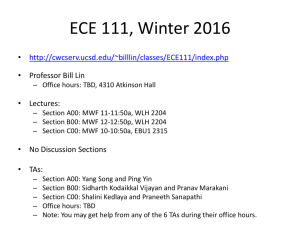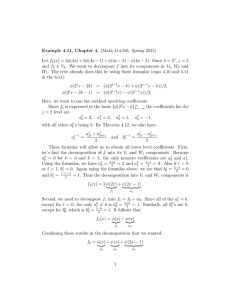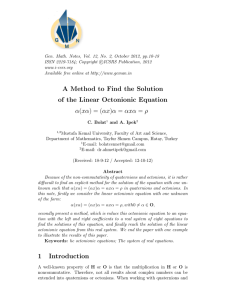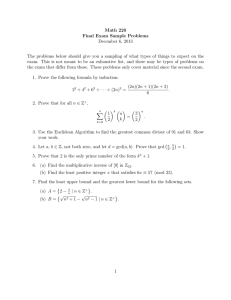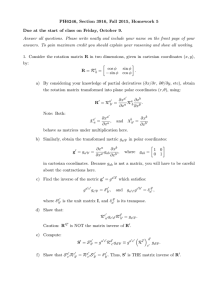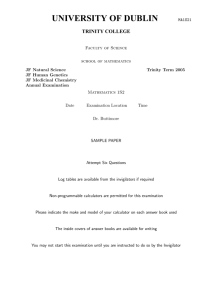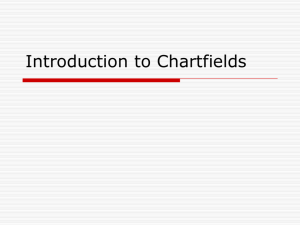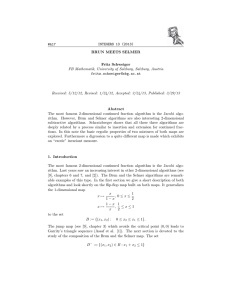Quiz #1
advertisement
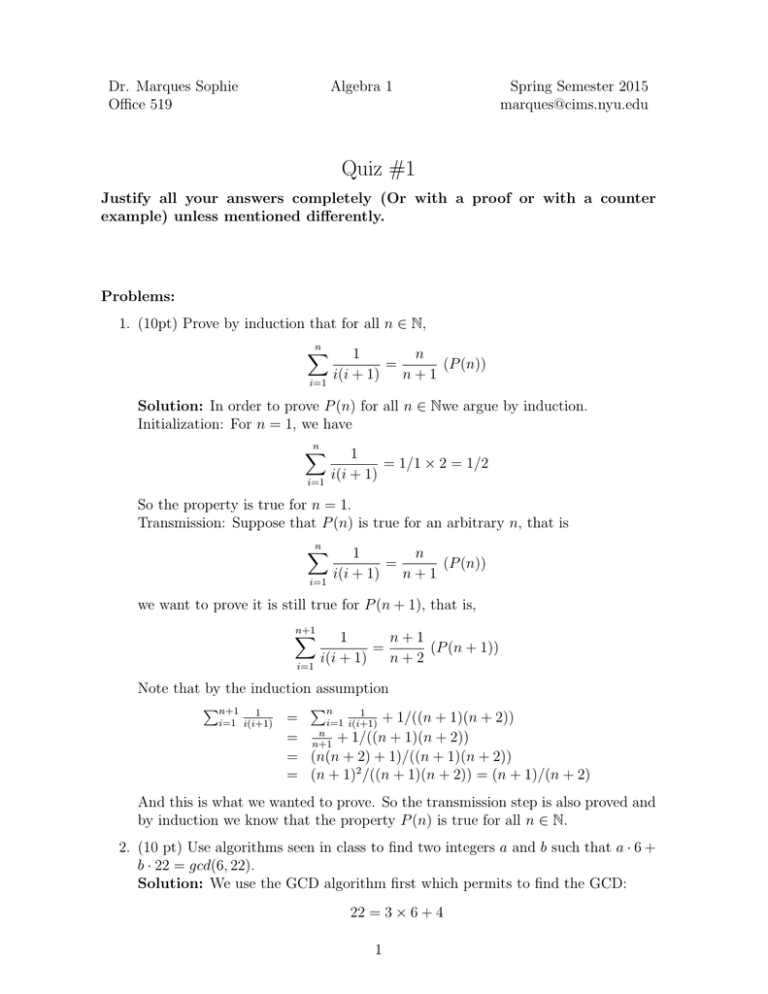
Dr. Marques Sophie
Office 519
Algebra 1
Spring Semester 2015
marques@cims.nyu.edu
Quiz #1
Justify all your answers completely (Or with a proof or with a counter
example) unless mentioned differently.
Problems:
1. (10pt) Prove by induction that for all n ∈ N,
n
X
i=1
1
n
=
(P (n))
i(i + 1)
n+1
Solution: In order to prove P (n) for all n ∈ Nwe argue by induction.
Initialization: For n = 1, we have
n
X
i=1
1
= 1/1 × 2 = 1/2
i(i + 1)
So the property is true for n = 1.
Transmission: Suppose that P (n) is true for an arbitrary n, that is
n
X
i=1
1
n
=
(P (n))
i(i + 1)
n+1
we want to prove it is still true for P (n + 1), that is,
n+1
X
i=1
n+1
1
=
(P (n + 1))
i(i + 1)
n+2
Note that by the induction assumption
Pn+1 1
Pn
1
i=1 i(i+1) =
i=1 i(i+1) + 1/((n + 1)(n + 2))
n
= n+1
+ 1/((n + 1)(n + 2))
= (n(n + 2) + 1)/((n + 1)(n + 2))
= (n + 1)2 /((n + 1)(n + 2)) = (n + 1)/(n + 2)
And this is what we wanted to prove. So the transmission step is also proved and
by induction we know that the property P (n) is true for all n ∈ N.
2. (10 pt) Use algorithms seen in class to find two integers a and b such that a · 6 +
b · 22 = gcd(6, 22).
Solution: We use the GCD algorithm first which permits to find the GCD:
22 = 3 × 6 + 4
1
6=4×1+2
4=2×2+0
The last non zero remainder being 2 we know that gcd(22, 6) = 2.
Then we use the extended gcd algorithm in order to find a and b.
2 = 6 − 4 = 6 − (22 − 3 × 6) = 4 × 6 − 22
3. (30pt) Denote by X the set {(a, b)|a ∈ Z, b ∈ Z\{0}}. We define a relation R on
X to be:
(a, b) ∼R (a0 , b0 ) ⇔ ab0 = a0 b
(a) Prove that R is a RST relation.
The relation R is reflexive indeed clearly (a, b) ∼R (a, b).
The relation R is symetric indeed
(a, b) ∼R (a0 , b0 ) ⇔ ab0 = a0 b ⇔ a0 b = ab0 ⇔ (a0 , b0 ) ∼R (a, b)
The relation R is transitive indeed
⇔
⇔
⇔
⇔
⇔
[(a, b) ∼R (a0 , b0 ) and (a0 , b0 ) ∼R (a00 , b00 )]
[ab0 = a0 b and a0 b00 = a00 b0 ]
[(ab0 )(a0 b00 ) = (a0 b)(a00 b0 )]
[(ab00 )(a0 b0 ) = (a00 b)(a0 b0 )]
[ab00 = a00 b]
(a, b) ∼R (a00 , b00 )
By commutativity, associativity and cancelation laws.
(b) One wish to define the sum of two equivalence class if possible. For this, we
propose to define for each (a, b) ∈ X and each (a0 , b0 ) ∈ X to be:
i. Show that the operation [(a, b)]R ⊕ [(a0 , b0 )]R := [(a, b) + (a0 , b0 )]R =
[(a + a0 , b + b0 )]R is not well defined (that is is not making sense).
Solution: Take (1, 2)R and (2, 3)R , we then have
[(1, 2)]R ⊕ [(2, 3)]R )] = [(3, 5)]R
and [(1, 2)]R = [(2, 4)]R . Note that
[(2, 4)]R ⊕ [(2, 3)]R )] = [(4, 7)]R
but [(4, 7)]R 6= [(3, 5)]R . So the definition depends on the representation
and thus this operation is not well defined.
ii. Show that [(a, b)]R ⊕ [(a0 , b0 )]R := [(ab0 + a0 b, bb0 )]R is well defined (that
is make sense, does not depend on the choice of the representatives).
In order to show that it is well defined we need to prove that the definition does not depend on the choice of the representative.
Let (a, b), (a0 , b0 ), (a0 , b0 ), (a00 , b00 ), such that [(a, b)]R = [(a0 , b0 )]R and
2
[(a0 , b0 )]R = [(a00 , b00 )]R . That is ab0 = a0 b and a0 b00 = a00 b0 We need to
prove that
[(ab0 + a0 b, bb0 )]R = [(a0 b00 + a00 b0 , b0 b00 )]R
That is
(ab0 + a0 b)b0 b00 = (a0 b00 + a00 b0 )bb0
Note that
(ab0 + a0 b)b0 b00 = (ab0 )(b0 b00 ) + (a0 b)(b0 b00 ) = (ab0 )(b0 b00 ) + (a0 b00 )(b0 b)
=
(a0 b)(b0 b00 ) + (a00 b0 )(b0 b) = (a0 b00 + a00 b0 )bb0
So, this operation is well defined.
(c) (Bonus) Does the quotient X/R is for you the ”same” of some familiar set ?
If yes which one. (No need to explain).
Solution: We can recognize the set of the rational Q (note that a/b =
a0 /b0 ⇔ ab0 = a0 b.
3

